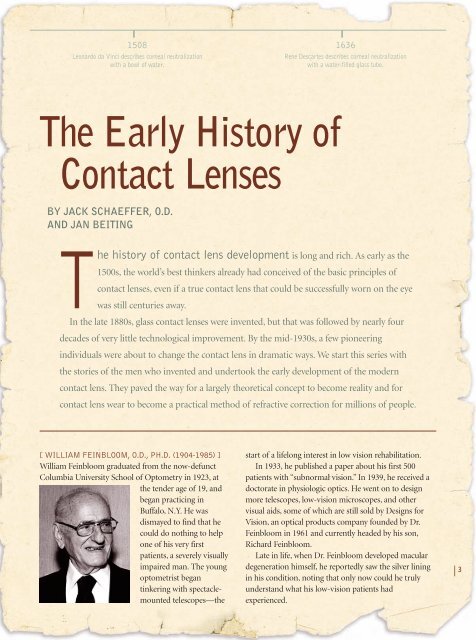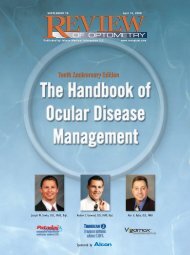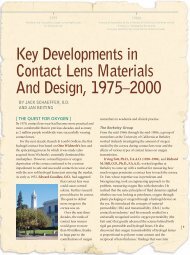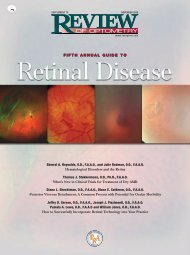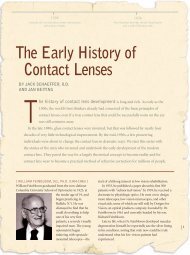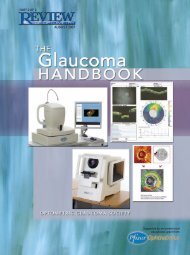Create successful ePaper yourself
Turn your PDF publications into a flip-book with our unique Google optimized e-Paper software.
1508<br />
Leonardo da Vinci describes corneal neutralization<br />
with a bowl <strong>of</strong> water.<br />
1636<br />
Rene Descartes describes corneal neutralization<br />
with a water-filled glass tube.<br />
<strong>The</strong> <strong>Early</strong> <strong>History</strong> <strong>of</strong><br />
<strong>Contact</strong> <strong>Lenses</strong><br />
BY JACK SCHAEFFER, O.D.<br />
AND JAN BEITING<br />
<strong>The</strong> history <strong>of</strong> contact lens development is long and rich. As early as the<br />
1500s, the world’s best thinkers already had conceived <strong>of</strong> the basic principles <strong>of</strong><br />
was still centuries away.<br />
contact lenses, even if a true contact lens that could be successfully worn on the eye<br />
In the late 1880s, glass contact lenses were invented, but that was followed by nearly four<br />
decades <strong>of</strong> very little technological improvement. By the mid-1930s, a few pioneering<br />
individuals were about to change the contact lens in dramatic ways. We start this series with<br />
the stories <strong>of</strong> the men who invented and undertook the early development <strong>of</strong> the modern<br />
contact lens. <strong>The</strong>y paved the way for a largely theoretical concept to become reality and for<br />
contact lens wear to become a practical method <strong>of</strong> refractive correction for millions <strong>of</strong> people.<br />
[ WILLIAM FEINBLOOM, O.D., PH.D. (1904-1985) ]<br />
William Feinbloom graduated from the now-defunct<br />
Columbia University School <strong>of</strong> Optometry in 1923, at<br />
the tender age <strong>of</strong> 19, and<br />
began practicing in<br />
Buffalo, N.Y. He was<br />
dismayed to find that he<br />
could do nothing to help<br />
one <strong>of</strong> his very first<br />
patients, a severely visually<br />
impaired man. <strong>The</strong> young<br />
optometrist began<br />
tinkering with spectaclemounted<br />
telescopes—the<br />
start <strong>of</strong> a lifelong interest in low vision rehabilitation.<br />
In 1933, he published a paper about his first 500<br />
patients with “subnormal vision.” In 1939, he received a<br />
doctorate in physiologic optics. He went on to design<br />
more telescopes, low-vision microscopes, and other<br />
visual aids, some <strong>of</strong> which are still sold by Designs for<br />
Vision, an optical products company founded by Dr.<br />
Feinbloom in 1961 and currently headed by his son,<br />
Richard Feinbloom.<br />
Late in life, when Dr. Feinbloom developed macular<br />
degeneration himself, he reportedly saw the silver lining<br />
in his condition, noting that only now could he truly<br />
understand what his low-vision patients had<br />
experienced.<br />
| 3
1823<br />
John Herschel proposes a glass capsule filled with animal jelly<br />
to correct astigmatism.<br />
1880s<br />
Adolph Fick, Eugene Kalt, and August Müller independently invent<br />
the first glass contact lenses.<br />
Like many pioneers, Dr. Feinbloom had a strong<br />
entrepreneurial spirit. In the 1930s, he developed the<br />
Feincone system for fitting scleral lenses and sold the trial<br />
lens sets to optometrists all over the country.<br />
“When I started practice in 1947, I tried to fit some<br />
patients with scleral lenses using this system and even<br />
wore them myself for a very short time,” remembers<br />
Robert Koetting, O.D., founder <strong>of</strong> <strong>The</strong> Koetting<br />
Associates, in St. Louis, Mo.<br />
Dr. Feinbloom was also one <strong>of</strong> the three original<br />
partners in Frontier <strong>Contact</strong> Lens Company <strong>of</strong> Buffalo,<br />
N.Y. That partnership dissolved long before Frontier<br />
[ GLASS CONTACT LENSES: 1500 TO 1935 ]<br />
4 |<br />
In 1508, Leonardo da<br />
Vinci sketched out several<br />
ideas for neutralizing the<br />
cornea through contact with<br />
fluid. He understood that<br />
corneal power could be<br />
altered by submerging the<br />
eye in a glass bowl filled<br />
with water, for example.<br />
Essentially, he described the<br />
principles <strong>of</strong> a contact lens<br />
without describing<br />
something we would actually recognize as a contact<br />
lens. 1 More than a century later, Rene Descartes<br />
described a glass tube filled with liquid and attached to<br />
the eye. This was hardly a contact lens; but again, the<br />
principle <strong>of</strong> corneal neutralization was clear.<br />
<strong>The</strong> first written description <strong>of</strong> a device<br />
approximating a contact lens is believed to date to<br />
1823. Sir John Herschel, an English astronomer,<br />
proposed “some transparent animal jelly contained in a<br />
spherical capsule <strong>of</strong> glass applied to the surface <strong>of</strong> the<br />
eye” to correct irregular astigmatism. 1 He also<br />
suggested that a mold <strong>of</strong> the cornea might be taken and<br />
impressed on some<br />
transparent medium.<br />
He thought it possible<br />
that “a temporary<br />
distinct vision” might<br />
be obtained through<br />
one <strong>of</strong> these methods,<br />
but it is not known<br />
whether Herschel<br />
ever tried to put his ideas into practice.<br />
In the late 1880s, at least three men are thought to<br />
have independently invented the first contact lenses.<br />
Adolph Eugen Fick, a Swiss ophthalmologist, and<br />
Eugene Kalt, a French ophthalmologist, devised glass<br />
lenses with the goal <strong>of</strong> correcting corneal<br />
abnormalities. Around the same time, August Müller, a<br />
German medical student who wanted to correct his own<br />
high myopia, also produced a glass lens.<br />
<strong>The</strong>se first contact lenses were crude by modern<br />
standards, made <strong>of</strong> blown<br />
glass bubbles or ground and<br />
polished glass, and were<br />
primarily scleral designs<br />
that covered much <strong>of</strong> the<br />
eye. <strong>The</strong>y were heavy and<br />
unwieldy and let no oxygen<br />
through to the cornea.<br />
Patients could tolerate the<br />
lenses only briefly and<br />
usually suffered from signs and symptoms <strong>of</strong> corneal<br />
hypoxia rather quickly. Nevertheless, the improvement<br />
in visual acuity that a piece <strong>of</strong> glass on the eye could<br />
provide was encouraging.<br />
Between 1890 and 1935, there were no<br />
developments <strong>of</strong> any great consequence. Two German<br />
companies, Karl Zeiss Optical Works and Mueller Co.,<br />
as well as small labs in the U.S. and elsewhere,<br />
continued to make glass contact lenses but demand was<br />
very limited. According to the American Academy <strong>of</strong><br />
Optometry, approximately 10,000 pairs <strong>of</strong> glass<br />
contact lenses were sold in the U.S. between 1935<br />
and 1939. 2
1936<br />
William Feinbloom introduces contact lens made partially from plastic<br />
PMMA introduced in U.S. by Rohm and Haas Co.<br />
1944<br />
Dr. Borish publishes his classic textbook, Clinical Refraction.<br />
began making the s<strong>of</strong>t contact lenses that were sold to<br />
Johnson & Johnson and eventually became known as the<br />
Acuvue brand contact lenses. He even patented some<br />
designs for bifocal and trifocal scleral contact lenses in<br />
the mid-1930s.<br />
But Dr. Feinbloom’s key contribution to the field <strong>of</strong><br />
contact lenses was recognizing the many advantages <strong>of</strong><br />
substituting plastic for glass in the eye. In 1936, he<br />
introduced and patented the first contact lens containing<br />
plastic. This lens had a central glass optic that covered<br />
the cornea with an opaque plastic flange over the sclera.<br />
At the time, glass contact lenses were the standard, but<br />
had never been very successful. Glass was transparent,<br />
but it had a number <strong>of</strong> disadvantages, including weight<br />
and complete lack <strong>of</strong> oxygen permeability that rapidly<br />
led to discomfort and corneal hypoxia for the wearer.<br />
<strong>The</strong> lenses were also difficult to make.<br />
With plastic, the lens weight could be reduced, the<br />
material could be formed and shaped easily, it had good<br />
compatibility with ocular tissue, and was more<br />
comfortable in the eye than glass.<br />
Initially, Dr. Feinbloom used the only plastic available<br />
to him—an opaque resin plastic that would not have<br />
been effective for the optical portion <strong>of</strong> the lens. But<br />
his ideas were prescient. PMMA, which has superb<br />
optical properties, was introduced in the U.S. that same<br />
year and rapidly became the material <strong>of</strong> choice for hard<br />
contact lenses.<br />
Many remember William Feinbloom as a tireless<br />
advocate. “My father was generous with his time and his<br />
knowledge,” recalls son Richard Feinbloom. “And he was<br />
passionate about helping people with low vision.”<br />
[ KEVIN M. TUOHY (1921-1968) ]<br />
In 1948, A California optician who worked for Solex<br />
Laboratories, Kevin Tuohy, filed a patent for the first<br />
corneal contact lens, which was made entirely <strong>of</strong> PMMA.<br />
His discovery began—as so many do—with a laboratory<br />
mistake. A scleral lens was accidentally lathed in two,<br />
leaving a smaller corneal button. Tuohy tried the<br />
damaged lens on himself to see what would happen. After<br />
more experimentation, he filed his patent and published a<br />
fitting manual for the new lenses.<br />
Mr. Tuohy’s contact lens was a large, thick, flat lens<br />
with blunt edges that would hardly be considered<br />
revolutionary today. But in the late 1940s, it marked a<br />
major shift from<br />
Poly (methyl 2-methylpropenoate)<br />
PMMA<br />
scleral to corneal<br />
contact lenses.<br />
Prior to this,<br />
many fine<br />
optometrists,<br />
ophthalmologists,<br />
and scientists—<br />
including <strong>The</strong>odore<br />
Obrig, Philip<br />
Salvatori, Ernest<br />
Mullen, Itsvan<br />
Gyorrfy, Solon Braff,<br />
and Edward Goodlaw—<br />
had been designing and producing all-PMMA lenses in<br />
scleral designs. PMMA was introduced in the U.S. by<br />
Rohm and Haas Company in 1936, and many<br />
laboratories began making plastic contact lenses on a<br />
limited scale shortly thereafter. <strong>The</strong>se lenses were a vast<br />
improvement on earlier glass lenses, especially with<br />
fitting modifications and new design elements such as<br />
fenestration; but they continued to suffer from the<br />
problem that all scleral lenses trapped tears between the<br />
lens and cornea, resulting in corneal hypoxia.<br />
Because <strong>of</strong> this, scleral contact lens fitting remained a<br />
very limited procedure undertaken by relatively few<br />
people around the world. But after the introduction <strong>of</strong><br />
the Tuohy corneal lens, contact lens sales increased from<br />
50,000 pairs in 1946 to 200,000 pairs in 1949. 2<br />
“<strong>The</strong> primary advantage <strong>of</strong>fered by this revolutionary<br />
combination <strong>of</strong> lightweight plastic and a corneal design<br />
was the potential for increased tear exchange behind the<br />
lens,” Mertz says <strong>of</strong> the Tuohy lens. 3 Patient comfort was<br />
still a limiting factor, but Mr. Tuohy’s innovation enjoyed<br />
great success by the standards <strong>of</strong> the day.<br />
<strong>The</strong> Tuohy lens served as the basis for ongoing design<br />
changes to PMMA lenses that dominated the market<br />
prior to the introduction <strong>of</strong> s<strong>of</strong>t contact lenses. <strong>The</strong> first<br />
and most important change was made by George<br />
Butterfield, who added peripheral curves to the posterior<br />
| 5
1948<br />
Kevin Tuohy patents first corneal contact lens (made <strong>of</strong> PMMA)<br />
<strong>Contact</strong> lens sales quadruple.<br />
1950<br />
George Butterfield introduces modern concept <strong>of</strong> fitting the lens on the Ks.<br />
6 |<br />
surface in 1950, introducing the modern concept <strong>of</strong><br />
fitting the lens on the Ks. 1 During the 1950s and 1960s,<br />
corneal PMMA lenses—made by Obrig Laboratories,<br />
Breger-Mueller-Welt in Chicago, and the Plastic <strong>Contact</strong><br />
Lens Co (Wesley-Jessen), among others—also became<br />
thinner and smaller.<br />
Unfortunately, PMMA, like glass, is impermeable to<br />
oxygen. <strong>The</strong> resulting corneal oxygen deprivation caused<br />
many problems for contact lens wearers that researchers<br />
would spend decades more trying to address.<br />
[ NEWTON K. WESLEY, O.D., F.A.A.O. (B. 1917) ]<br />
Newton K. Wesley, O.D., is <strong>of</strong>ten<br />
credited with developing the first<br />
commercially successful rigid<br />
contact lens, in the mid-1950s.<br />
His lens, building on what Tuohy<br />
and Butterfield had done, was a<br />
9.2-diameter lens, fit on the<br />
flattest K. “It’s interesting that, all these years later, 9.2 is<br />
still the best diameter,” said Frank Fontana, O.D., one <strong>of</strong><br />
the founders <strong>of</strong> the AOA <strong>Contact</strong> Lens Section.<br />
But his greatest contribution to the field <strong>of</strong> contact<br />
lenses may have been in his teaching skills. Dr. Wesley<br />
and a former student <strong>of</strong> his, George Jessen, O.D.,<br />
together started the Plastic <strong>Contact</strong> Lens Company, later<br />
to be called Wesley Jessen VisionCare, Inc., a leading<br />
manufacturer <strong>of</strong> specialty contact lenses, including toric,<br />
colored and opaque cosmetic lenses. Wesley Jessen was<br />
eventually acquired by CIBA Vision in 2001.<br />
“Wesley and Jessen taught all <strong>of</strong> us how to fit contact<br />
lenses,” Dr. Fontana said. “<strong>The</strong>y almost single-handedly<br />
developed the market for contact lenses, just by traveling<br />
around the country educating people.” At the time,<br />
contact lens fitting was still a new field, and many<br />
thought contact lenses were unsafe; but Dr. Wesley and<br />
Dr. Jessen believed wholeheartedly in them. <strong>The</strong>y<br />
continued to develop new lenses for decades, achieving<br />
FDA approval <strong>of</strong> their own hydrogel s<strong>of</strong>t contact lenses<br />
in 1978.<br />
In 1955, Dr. Wesley founded the National Eye<br />
Research Foundation, best known for its orthokeratology<br />
and keratoconus work, and remained its chairman for<br />
many years. In the 1990s, he pursued s<strong>of</strong>tware<br />
applications for retinal sensitivity analysis. Well into his<br />
80s, Dr. Wesley continued to be an active entrepreneur<br />
and innovator.<br />
[ OTTO WICHTERLE, PH.D. (1913-1998) ]<br />
Otto Wichterle was a brilliant Czech<br />
polymer chemist who had<br />
already worked on one<br />
<strong>of</strong> the world’s first<br />
synthetic fibers. In 1954,<br />
he and colleague<br />
Drahoslav Lim at the<br />
Institute <strong>of</strong><br />
Macromolecular Chemistry<br />
<strong>of</strong> the Czechoslovak<br />
Academy <strong>of</strong> Sciences<br />
invented the first hydrogel<br />
material, hydroxyethyl<br />
methacrylate (HEMA). <strong>The</strong>y were seeking a synthetic<br />
biocompatible material for implants elsewhere in the<br />
human body and initially published their findings in<br />
the journal Nature in a 1959 article entitled<br />
“Hydrophilic gels for biological use.”<br />
When a chance encounter with an ophthalmologist<br />
on a train gave Pr<strong>of</strong>. Wichterle the idea that the gels<br />
he was working with would also be effective in the<br />
eye, he began his successful quest to make a contact<br />
lens. He later worked with American collaborator<br />
Robert Morrison, O.D., and others to improve<br />
the lenses.<br />
<strong>The</strong> original Wichterle lenses provided relatively<br />
poor acuity with thick yellowish material, but they were<br />
comfortable, according to Mandell. 1 <strong>The</strong> HEMA<br />
material was transparent, free <strong>of</strong> impurities, and was<br />
permeable to oxygen and water-soluble nutrients. Pr<strong>of</strong>.<br />
Wichterle patented his lenses in the U.S. in 1962 and<br />
1965. Mandell notes that these original lenses were by<br />
no means a great success prior to their refinement and<br />
commercialization by Bausch & Lomb, 1 which<br />
eventually acquired the patents for the HEMA contacts.<br />
Pr<strong>of</strong>. Wichterle quickly realized that he also needed a<br />
faster, more reliable method <strong>of</strong> fashioning the HEMA
1952<br />
Dr. Goodlaw suggests that contact lens wear could cause corneal edema.<br />
1954<br />
Otto Wichterle and Drahoslav Lim invent HEMA.<br />
material into a contact lens than the closed-mold<br />
process he’d been using. With various combinations <strong>of</strong><br />
his children’s construction toys, a hot plate, bicycle<br />
parts and a phonograph motor, he built a<br />
primitive spin casting device—<br />
something that was familiar to<br />
polymer chemists for other<br />
applications but had never been<br />
used for contact lenses.<br />
“This device was no toy,”<br />
Morrison said. “It was a clever<br />
creation in which raw liquid HEMA<br />
polymer was introduced via a tube into a mold that<br />
was spinning.” 4 Heat from the hot plate was the catalyst<br />
to turn the liquid HEMA into a gel. Technicians at his<br />
institute helped him automate the device, which he<br />
would later patent (in 1961) as a method for making<br />
s<strong>of</strong>t lenses. He and his wife manufactured 5,500 lenses<br />
in 1962 with the spin casting machine. 1 At the time, he<br />
reportedly thought the low cost and high<br />
reproducibility <strong>of</strong> spin casting could make a disposable<br />
lens approach economically feasible, although it would<br />
be many years before that would become reality. 3<br />
Pr<strong>of</strong>. Wichterle’s contact lens work<br />
was <strong>of</strong>ten hindered for political<br />
reasons and was not fully<br />
appreciated until late in his<br />
life. When Germany<br />
invaded Czechoslovakia in<br />
World War II, the Nazis<br />
closed the<br />
universities,<br />
interrupting his<br />
research, and even<br />
imprisoned him for<br />
a few months. Later,<br />
<strong>Contact</strong>s were formed by filling small<br />
molds with liquid plastic and allowing<br />
them to harden. <strong>The</strong>se “buttons” were<br />
then cut to correct prescriptions.<br />
when Czechoslovakia<br />
came under Soviet<br />
influence, he was<br />
thrice removed from<br />
senior positions in political purges. In one case, he lost<br />
his position as head <strong>of</strong> the Institute <strong>of</strong> Macromolecular<br />
Chemistry (where he developed HEMA), due to his -<br />
support for the unsuccessful anti-communist Prague<br />
Spring uprising. Finally, after the 1989 “Velvet<br />
Revolution” and Czechoslovakia’s turn toward<br />
democracy, he was named president <strong>of</strong> the Czech<br />
Academy <strong>of</strong> Sciences and recognized for his<br />
contributions.<br />
But while Pr<strong>of</strong>. Wichterle struggled against<br />
political forces in his own<br />
country, his concept <strong>of</strong> a<br />
lens comfortable enough to<br />
be worn for a good portion <strong>of</strong><br />
waking hours had revolutionized<br />
the contact lens field elsewhere. Within<br />
just a few years after Bausch & Lomb<br />
commercialized his lenses (and the spin casting<br />
technique, which the company also acquired), the vast<br />
majority <strong>of</strong> Americans wearing contact lenses were<br />
wearing hydrogel contact lenses, and millions <strong>of</strong> people<br />
worldwide still wear them.<br />
[ ROBERT MORRISON, O.D. (B. 1924) ]<br />
Robert Morrison, a self-described “mediocre student,”<br />
dropped out <strong>of</strong> college to join the Army during World<br />
War II. He decided on optometry because Pennsylvania<br />
College <strong>of</strong> Optometry was accepting veterans without<br />
full college degrees. After graduation, the ambitious<br />
young doctor built a thriving practice in his hometown<br />
<strong>of</strong> Harrisburg, Pa., which he later expanded to a parttime<br />
practice in New York City, as well. He was very<br />
interested in contact lenses and had already been<br />
making rigid contact lenses in a small optical lab in his<br />
<strong>of</strong>fice when he heard about Otto Wichterle’s paper on<br />
hydrophilic gels. In 1961, Dr. Morrison traveled to what<br />
was then Czechoslovakia, and brought some <strong>of</strong> the<br />
material back home with him. He wasn’t the first<br />
person to visit Pr<strong>of</strong>. Wichterle and hear about his new<br />
lens technology—but he was the first to embrace the<br />
potential <strong>of</strong> a hydrophilic material for contact lenses.<br />
“Wichterle’s accomplishments might have died<br />
behind the iron curtain were it not for the persistence<br />
<strong>of</strong> Robert Morrison,” said Joe Shovlin, O.D. Dr.<br />
Morrison and Pr<strong>of</strong>. Wichterle traded ideas back and<br />
forth over several years, and Dr. Morrison became the<br />
| 7
Mid 50s<br />
Plastic <strong>Contact</strong> Lens Co (Wesley Jessen) and others make commercially successful PMMA lenses.<br />
Newton Wesley and George Jessen began an education campaign to teach their peers how to fit contact lenses.<br />
first American to fit the lenses in practice. <strong>The</strong> two were<br />
close friends for a while, although the friendship was<br />
strained by the legal wrangling that surrounded the<br />
transfer <strong>of</strong> Wichterle’s HEMA patents.<br />
Dr. Morrison was eager to have the patents in order<br />
to continue his own work with s<strong>of</strong>t contact lenses, but<br />
he was forced to share them with a group called the<br />
National Patent Development Corporation (NPDC).<br />
it,” said Dick Thornburgh, former U.S. Attorney<br />
General, former Governor <strong>of</strong> Pennsylvania, and a<br />
longtime patient <strong>of</strong> Morrison’s.<br />
Dr. Morrison enjoyed a long career treating patients,<br />
lecturing and teaching. He recently published a book<br />
about his life and career. 4 “I wrote it for my<br />
grandchildren,” Dr. Morrison said. “I wanted to make<br />
sure they got the facts straight when they hear some <strong>of</strong><br />
the tall tales about their grandfather.”<br />
8 |<br />
<strong>The</strong> NPDC bought out Morrison’s share soon thereafter<br />
and eventually licensed the technology to Bausch &<br />
Lomb, which refined it and brought the first s<strong>of</strong>t<br />
hydrogel contact lens, the S<strong>of</strong>lens (polymacon), to<br />
market in 1971. <strong>The</strong> FDA decided the lens was a drug,<br />
which created a major hurdle for B&L. Once past that<br />
hurdle, however, the company enjoyed a three-year<br />
monopoly on s<strong>of</strong>t contact lenses in the U.S., during<br />
which time it dominated the marketplace and PMMA<br />
became nearly obsolete.<br />
In addition to serving as the bridge between Otto<br />
Wichterle and the West, Dr. Morrison was a skilled<br />
contact lens fitter who truly had one <strong>of</strong> the first<br />
optometric practices to specialize in the young field <strong>of</strong><br />
contact lenses. He became known as the eye doctor <strong>of</strong><br />
the rich and famous, treating Hollywood stars and<br />
international royalty, and once received a Rolls Royce<br />
from Queen Juliana <strong>of</strong> the Netherlands as payment for<br />
his services. More than 40 years later, he still drives that<br />
car sometimes.<br />
“Dr. Bob has shown how much one person can<br />
contribute to the world during a lifetime, and how<br />
much fun and adventure he can experience while doing<br />
All <strong>of</strong> the individuals described here were pathcutters,<br />
charting a difficult way in completely unknown<br />
territory. <strong>The</strong>y laid the foundations for both rigid and<br />
s<strong>of</strong>t contact lenses and established a role for contact<br />
lenses in refractive correction that is now taken for<br />
granted. But in some ways, they raised more questions<br />
than they answered: What were the oxygen<br />
requirements <strong>of</strong> the cornea? Was there a material<br />
that would be comfortable and healthy over the long<br />
term? How long could contact lenses be worn? How<br />
should they be fit? How did one manage a contact<br />
lens practice?<br />
In future installments <strong>of</strong> this series, we’ll look at<br />
the people and the companies that refined lens<br />
material and design, built the manufacturing<br />
capabilities to revolutionize the industry, educated<br />
their colleagues about fitting, marketing, and the<br />
oxygen requirements <strong>of</strong> the cornea, and built the first<br />
contact lens specialty practices.<br />
1. Mandell RB. Historical development. In: Mandell RB. <strong>Contact</strong> lens<br />
practice. Springfield, Ill.: Charles C. Thomas, 1988:5-20.<br />
2. Kuwabara DM. <strong>History</strong> <strong>of</strong> the Cornea & <strong>Contact</strong> Lens Section,<br />
American Academy <strong>of</strong> Optometry website.<br />
3. Mertz GW. Development <strong>of</strong> contact lenses. In: Hamano, H and<br />
Kaufman H E. Corneal physiology and disposable contact lenses.<br />
Boston: Butterworth-Heineman, 1997:65-99.<br />
4. Knorr R, Kremer K. Man <strong>of</strong> Vision: <strong>The</strong> Story <strong>of</strong> Dr. Robert<br />
Morrison. Osprey, Fla.: SIS Publishing, 2006.<br />
[ SPECIAL THANKS ]<br />
Special thanks to contributors Robert Davis, O.D.; Art<br />
Epstein, O.D.; and Glenda Secor, O.D., for their assistance<br />
with this series.


